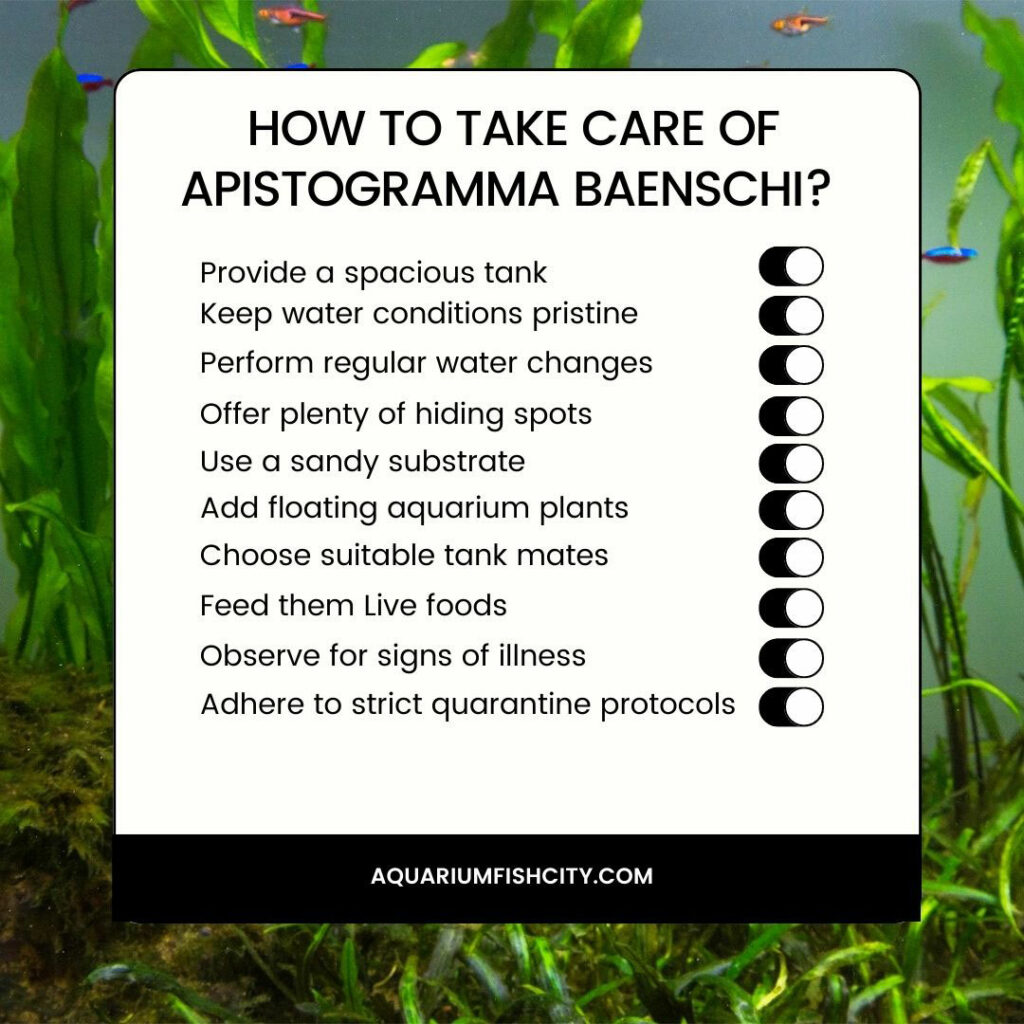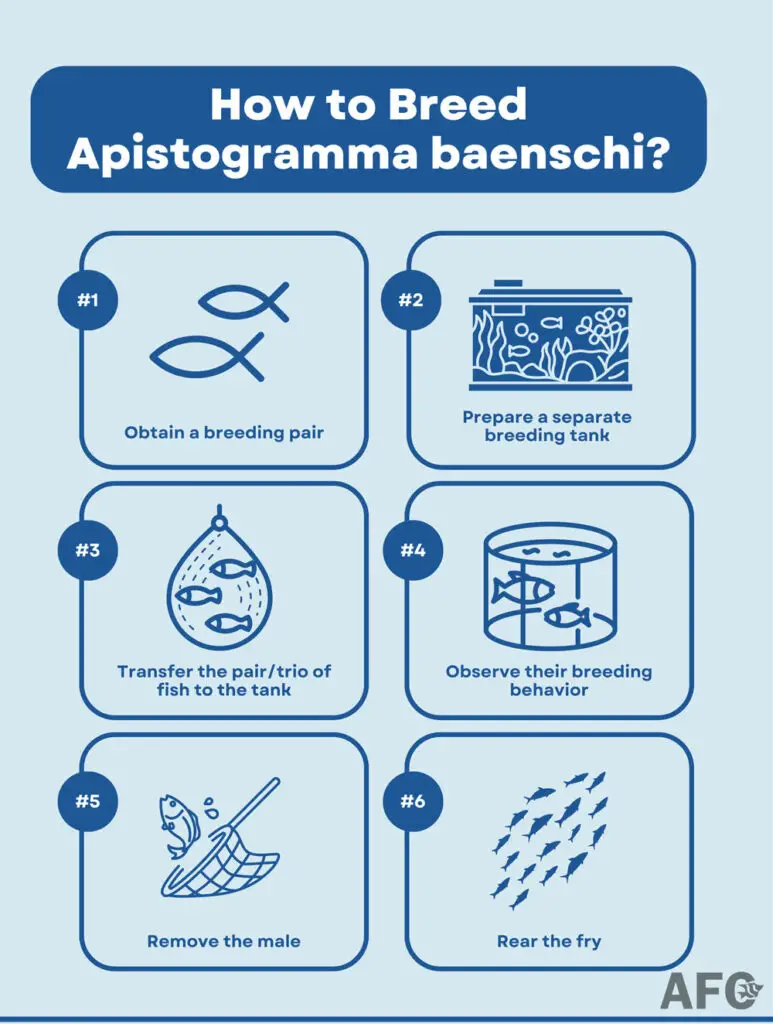Apistogramma baenschi, also known as Apistogramma Inka or Apistogramma Inka 50, is a species of dwarf cichlid fish native to the blackwater tributaries of the lower Huallaga River in Peru. It is known to be less demanding of pH levels than other Apistos from similar habitats.
This fairly new species has garnered praise in the global dwarf cichlid community since it was introduced to the U.S. and Europe in early 2003. Its stunning appearance has made it a favorite among enthusiasts.
Gender differences become apparent as they reach maturity, though they can sometimes be mistaken for their close relatives.
Despite their small size, A. baenschi are much more aggressive compared to other species of Apistogramma. Both males and females can display more aggressive behavior than usual during spawning seasons.
This guide will provide you with the characteristics, care requirements, and breeding instructions for Apistogramma baenschi in order to keep your fish healthy and help them live longer.
What is The Natural Habitat of Apistogramma baenschi?
Apistogramma baenschi is only found in small tributaries of the lower Huallaga River, the major tributary of the Marañón River, a part of the Amazon Basin in northern Peru.
In their native habitat, A. baenschi inhabit small, very shallow rainforest black water streams surrounded by shady trees and other plant life on the banks. They typically live at the bottom of a riverbed with fine white sand, tons of leaf litter, fallen branches, and some driftwood.
The waters are characterized principally by their lower total dissolved solids (TDS) (< 50 ppm), cooler water temperatures around 75 to 79°F (24 to 26°C), and very low hardness (GH < 5 dGH). However, unlike other blackwater Apistogramma species, like A.elizabethae or A. nijsseni, A. baenschi thrives in a wider range of pH levels from 4.1 to 6.3, according to its collection data.
How Big do Apistogramma baenschi Get?
Apistogramma baenschi males grow to about 3 inches (8 cm) in total length (from the tip of the snout to the end of the tail), while females stay smaller, reaching a maximum size of 2.3 inches (6 cm) in total length, according to the book “Baensch Cichlid Atlas, Vol. 2 (v. 2)” by Uwe Romer.
How to Tell a Male From a Female Apistogramma baenschi?
These are four ways to tell a mature male from a female Apistogramma baenschi.
- Determine the length: Males are typically larger than females.
- Examine their coloration: Males are more vividly colored and have an iridescent, light blue-green colored body, while females are less colorful with a yellow body that is accented by black vertical stripes.
- Inspect their dorsal fins: The male’s dorsal fin is elongated and pointed and develops long extensions, while the female’s dorsal fin is short and even.
- Observe their caudal (or tail) fin: In males, the caudal fin has a red outer edge (rim), which is absent in females.

Are Apistogramma baenschi Aggressive?
Yes, Apistogramma baenschi are more aggressive than other Apistogramma dwarf cichlids. This is because they are categorized as an “opportunistically” monogamous fish, meaning the male can form a tight bond with a single female for one or several breeding seasons. As a result, both sexes are likely to be more selective about their relationship partners. A male may chase away any other males to ensure their exclusive relationship with a particular female, or toward females who are unwilling to accept him. Once they pair up, the pair often displays aggressive behavior against the unselected females and other intruders.
Additionally, some females are known to become overly aggressive while guarding eggs or fry, particularly showing aggression towards the male attempting to spawn with her again. In severe cases, they may even bite or bump the males. This usually happens when the fish are kept in small tanks or there are not enough hiding places available for the males.
How Long Do Apistogramma baenschi Live?
Apistogramma baenschi typically live for about 2 years in captivity, as indicated by a 1991 statistical study conducted by Dr. Sven O. Kullander. This study involved 7,532 aquarium-raised specimens from 23 different Apistogramma species, all of which were at least 9 months old and selected based on unbiased criteria, with their hatching dates meticulously recorded.
The study found that only 8% of the fish survived beyond 24 months of age, and a significant portion, approximately 75%, had already perished by the time they reached 18 months. Furthermore, around 33% of the specimens did not survive their first year. Interestingly, most of the fish that lived beyond 2 years were males.
As with any freshwater aquarium fish, the lifespan of Apistogramma baenschi is influenced by a number of factors, including the quality of their water, their diet, and their overall health. Setting up an environment that closely simulates their natural habitat can significantly contribute to their longevity.
How to Take Care of Apistogramma baenschi?
Here are 10 important ways to take good care of Apistogramma baenschi in the home aquarium
- Provide a spacious tank. The minimum tank size for a breeder pair or a trio of Apistogramma hongsloi is 20-gallon Long (75 liters). You need to give each female a minimum territory of approximately 12 inches (30 cm) if you want to breed them in a harem situation with several females.
- Keep water conditions pristine. The water should closely mimic the rivers from which they originate, with a temperature of 75 to 79°F (24 to 26°C), pH between 4.1 and 6.3, low hardness (GH < 5 dGH), and a low total dissolved solids (TDS < 50 ppm). To achieve the desired water chemistry, peat moss, Apistogramma-safe leaves, and reverse osmosis deionized (RO/DI) systems are commonly used by fish keepers.
- Perform regular water changes. Change 10 to 15 percent of the water each week and monitor the water parameters on a daily basis.
- Offer plenty of hiding spots. Inca cichlids are very territorial when breeding and need to have plenty of hiding places. Upturned flower pots, bogwoods, coconut shells, or rock caves can be used to provide the necessary cover.
- Use a sandy substrate. Similar to their larger Geophagus cousins, Apistos enjoy sifting through the substrate. To keep them happy, use fine-grained sand (0.5-1.7 mm grain size) and the addition of Indian Almond Leaves (IAL) and Oak Leaf Litter.
- Add floating aquarium plants. When selecting live plants for Apistogramma baenschi, floating plants are preferred, as they do not compete for your fish’s swimming space and also reduce the lighting.
- Choose suitable tank mates. Suitable tankmates include South American tetra, pencilfish, hatchetfish, and small members of the catfish family, such as Corydoras catfish and Otocinclus catfish. Freshwater angelfish can coexist peacefully with Apistogramma hongsloi, provided they are kept in a large, well-planted tank.
- Feed them Live foods. To meet their dietary requirements, offer them a variety of live foods such as baby brine shrimp, daphnia, glassworms, bloodworms, and black and white mosquito larvae.
- Observe for signs of illness. Apistos are susceptible to many common aquatic illnesses, including Ichthyophthirius multifiliis(Ich), Learnea spp. (Anchor worms), and other bacterial infections. As with any aquarium fish, early detection is essential for successful treatment.
- Adhere to strict quarantine protocols. Quarantine any new arrivals to minimize the chances of introducing diseases or parasites into your tank.

Are Apistogramma baenschi Easy to Care For?
No, Apistogramma baenschi are not the easiest Apistogramma fish to care for, and they would be best for intermediate to experienced aquarists who are interested in setting up South American botanical-style aquariums.
If you’re looking for easy-to-care-for Apistogramma types, we recommend looking at Apistogramma borellii or Apistogramma macmasteri. Both are quite hardy and do well in aquariums without all the extra fuss required for Apistogramman baenschi.
How to Breed Apistogramma baenschi?
Here is a step-by–step guide to successfully breeding Apistogramma baenschi in the aquarium.
Step 1: Obtain a breeding pair
There are two ways to get a breeding pair:
- Purchase a pair from a specialized dealer. This is the most common method, but it can be expensive.
- Keep a large group of juvenile fish (at least two males and 6-8 females) and allow them to pair off. This is a less expensive option, and it increases your chances of getting a strong, healthy pair that will produce robust fry.
The latter method is preferred because it gives the fish more time to mature and develop their personalities. This can lead to more successful breeding, as the fish will be more likely to choose a compatible mate. Additionally, keeping a larger group of fish helps to reduce aggression, as there are more fish to disperse the aggression.
Step 2: Prepare a separate breeding tank
A separate spawning tank is important. Ensure the water hardness in the breeding tank ranges from 1 to 5 dGH, with a total dissolved solids (TDS) lower than 50 ppm. Water temperature and pH levels are related to the sex of fry. To get a gender ratio of 1:1, maintain water temperatures between 75 to 77°F (24 to 25°C) and pH levels between 5.5 and 6. However, if you intend to yield more females, slightly lower the water temperature and raise the pH.
Dim lighting, a sandy substrate, and spawning sites are essential for the breeding tank. In addition, provide plenty of floating plants and add a group of pencilfish or hatchetfish to the tank as dither fish.
Step 3: Transfer the pair/trio of fish to the tank
Select the most colorful male and two females from the group if you have a harem, and then transfer them into the breeding tank. Monitor them for a few days to ensure they get along well.
Generally, the male will consider the entire tank as his territory, and each female will have her own territory within the tank.
Step 4: Observe their breeding behavior.
Once a female is ready to spawn, she starts courting the male near her spawning cave. If the male performs tail-beating, this indicates that he accepts the female as a spawning mate. The breeding pair may start to chase away any fish in the tank, including the unselected female.
The female will lay between 50 and 100 eggs (depending on the female) that float upwards into the nest. After the eggs have been laid, you may notice that she will attempt to cover the cave entrance with sand.
The eggs will hatch in approximately 36 to 72 hours, and the fry will start free-swimming after 6-8 days (depending on temperature).
Step 5: Remove the male
After spawning, females may allow the male to participate in rearing the offspring, but some may chase the male away. If you notice aggression towards the male, it is best to remove him from the tank.
Step 6: Rear the fry
The fry are very tiny, measuring only (0.9 to 1.2 inches) 2.5-3 cm TL. Once they are free-swimming, feed them with very small foods like infusoria or rotifers. As they grow, introduce freshly hatched brine shrimp and other small-sized live foods. Perform more frequent water changes of 10-15% daily during this stage.






